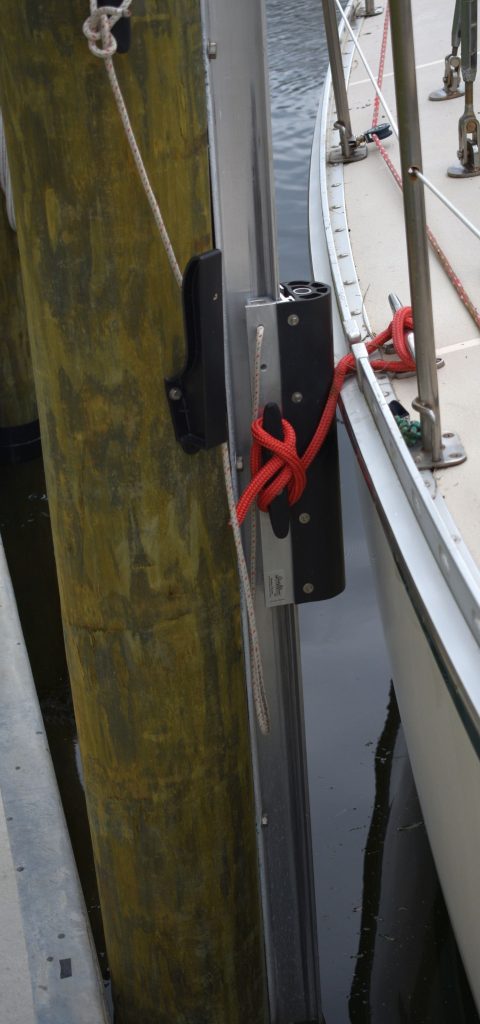The new 45′ long dock is connected to the old 30′ dock, which results in a nice long parking spot for Mirador. The five new pilings and two old pilings provide strong and secure spots to tie Mirador in place. The normal daily tide range here in Punta Gorda is a foot or less except during the new moon phase where we might see 20 to 24 inches difference between high and low tide. However, the dock is at a fixed height and does not move up or down with the tide changes.
Our experience with Hurricane Irma in September 2017 made us think we needed more than just a a set of fixed cleats or connections between Mirador and the pilings or dock. Mirador was secured at a fixed dock / finger pier in Burnt Store Marina during Irma. The normal low tide water depth at that spot was about eight feet, which meant there was more than 2.5-feet of water under Mirador’s keel bottom at a 0′ tide. The lowest tide we have seen during that two years we’ve had Mirador in Charlotte Harbor is -1′ (minus one-foot) so even then there was more than a foot under Mirador’s keel.
However, during Irma ALL the water flowed out of the Burnt Store Marina and Mirador ended up sitting on the bottom and leaning on the finger pier pilings. That put an enormous load on the lines I secured from the dock cleats and finger pier pilings to Miradors deck cleats, mast, and mainsheet winches. I had secured those 24 (yes 24-lines some of them new 1″ double braid) lines at about a one-foot tidal level and Mirador, resting on the bottom was more than three-feet below that level.
Mirador remained on the bottom, during Irma, for about six-hours while the wind clocked around from NNE to SSW, again placing a huge load on the dock lines. Many of the finger piers and finger docks in Burnt Store came loose during this time.
The water then rushed back into the marina and surged up to a 5′ level which is right at the top of most of the finger pier pilings.
We wanted to make a more flexible and adjustable method for attaching Mirador to the new dock pilings.
The Slide-Moor system had a lot of rave reviews on the internet and was highly recommended by the dock contractor. They had installed several dozen Slide-Moor systems during the last 15-years and no boat secured by Slide-Moor had come loose or had been damaged.
A home just 50-yards down the canal from us had a Slide-Moor system in place for a Catalina 47. The said their boat sat quietly at the dock during the 65-knot Irma gusts and stayed secure when it ended up resting on the bottom as all the water in the canal system was sucked out into Charlotte harbor.

The Slide-Moor system is an aluminum T-rail mounted vertically on a piling. An 18″ long car rides up and down on the T-rail. That car has a black rubber bumper that rests against Mirador’s stainless rub rail. There is a stout cleat on either side of the car.

The key to the strength of the system is that the red line from one sliding car cleat to the boat’s clean and then back to the other car cleat can be pulled extremely taut, which results in no play and no movement of the boat either fore/aft or side to side. No matter how much the wind gusts the boat can never move or build any momentum.

I was somewhat skeptical of the system’s strength when we had our first extended “Norther” blow. The NNE wind was gusting into the mid-40 knot range and blowing the port stern of the boat off the dock. It seemed strange to me to have only two 1/2″ lines securing Mirador to the pilings.

I spent quite a bit of time talking to a Slide-Moor engineer who lives in Naples, Florida, which is about 45-miles south of here. I described the local wind hitting Mirador and he said he was getting even stronger winds at his dock in Naples. He was absolutely certain two ( just 2 !) of their 1/2″ lines were adequate to secure a Caliber 40 to the pilings in any conditions.
He said they had done extensive engineering studies and had 20-years of practical experience. Slide-Moor does not recommend a third 1/2″ piling / track/ car/ line until the boat length exceeds 60-feet. And they never use and heavier line to secure the boat to the sliding cars.



hi. can you tell me about anchoring a Caliber 40? Ive heard that the chain must be flaked by hand when raising the anchor. this would make single-handing a bit more difficult. Thanks for any information you can provide.
M.
The standard Caliber 40 anchor locker does not have enough vertical room to allow for a free chain fall so You are correct about hand flaking. We heavily modified the anchor locker to allow for easy no-hands chain fall. You can see lots of pictures of our system on the Significant Upgrades page here or on our old website at: http://www.svmirador.net/February_16_2004.htm
Our old website http://www.svmirador.net has thousands of pictures and stories about cruising in the Sea of Cortez and a lot of interesting stuff about my single handing.
I setup the anchor windlass to be reversible and to have a 40′ remote control cable so I can operate from the front of the bow rollers or from the cockpit.
Mirador is setup for very easy single handing – I did about 6,000 miles single handed in Puget Sound, the Pacific Ocean, and the Sea of Cortez. It was a great experience.
did you note that Mirador is for sale at a huge discount over other Caliber 40s? You can buy a fundamentally sound boat with a great inventory of cruising equipment and customize her as you wish with upgrades.